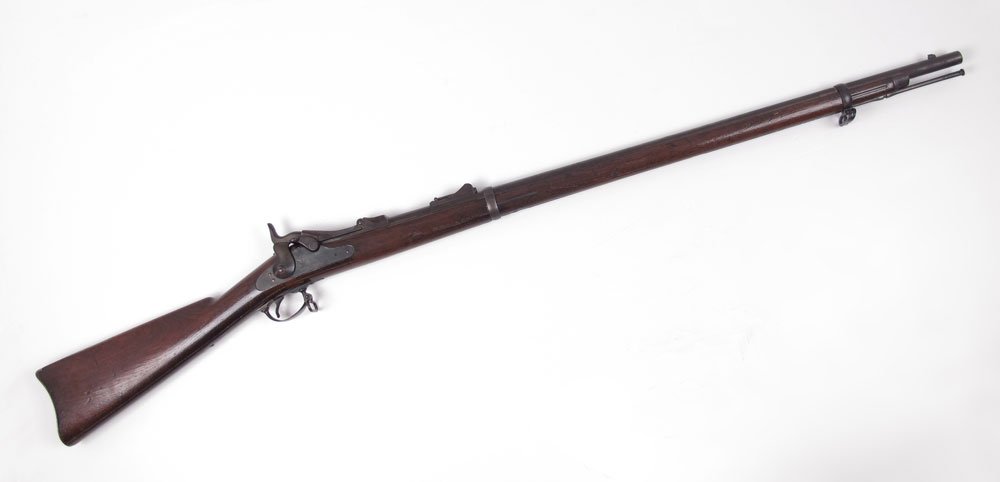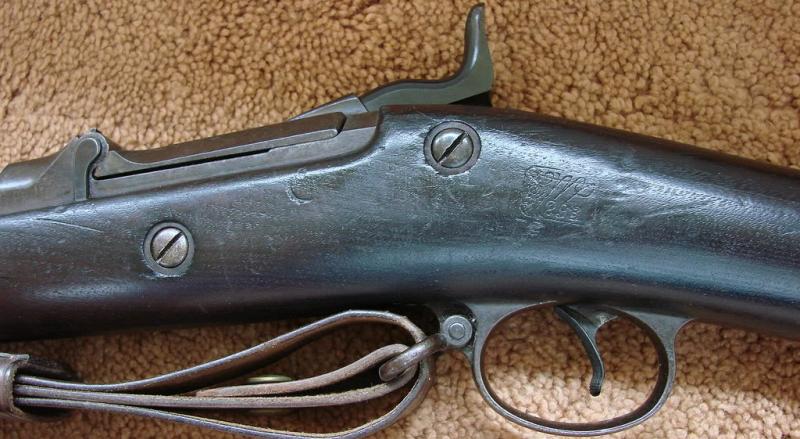Rare Custer Era U.S. Springfield Model 1873 Trapdoor Carbine with Documentation This is a wonderful example of a rarely encountered U.S. Springfield Model 1873 Carbine manufactured circa late 1873 which falls right in the middle of the noted Custer era serial number range carbines; (33,000-43,700).
- Sioux Parfleche Tacked Springfield Trapdoor
Rifle: The lot features a U. S. Springfield Model 1873 Trapdoor Rifle most likely chambered in . 45-70 that has been heavily used and adorned by a Sioux Native American Indian. ... [more like this] - U.S. Springfield Trapdoor- Sporterized Springfield
Trapdoor Rifle, Trapdoor Dated 1866 with Eagles head present, Side Lock Plate Dated 1865 with strong U.S. Springfield markings and Full Eagle, Blued barrel shortened to 26', ... [more like this] - MODEL 1873 US SPRINGFIELD TRAPDOOR RIFLE:
Serial number 421XXX range, which dates to 1888. Well marked with US Springfield and eagle on lock, inspector marks on barrel, cartouche on stock opposite lock. Previous owners ... [more like this] - MODEL 1873 US SPRINGFIELD TRAPDOOR RIFLE:
1874 Production, serial number #14759. Nice clear US Springfield and eagle markings. Inspector stamps on barrel V. P. P. and B., inspector cartouch on stock opposite plate. ... [more like this] - U.S. Springfield Trapdoor Rifle 24 in. barrel,
trapdoor marked 'US/Model/1878', serial number 33295', lockplate marked 'US Springfield' with an eagle, extensive brass tack decoration, 'RHB' carved in block on stock, Buffington ... [more like this] - Model 1889 Springfield Trapdoor Rifle with
Rod Bayonet .45-70 cal. 32.5' round barrel with large VP and eagle S/N 97245.? 1884 dated breechblock. Buffington rear sight.?Walnut stock with firing proof behind the triggerguard ... [more like this] - U.S. Model 1873 Springfield Trapdoor Rifle.Serial
# 237889 Standard issue rifle with 32-5/8' barrel chambered for the .45-70 cartridge. All metal parts are in smooth blue-brown patina with light freckling. All proper U.S. ... [more like this] - U.S. Springfield Trapdoor Rifle.Serial #
315234 This Model 1873 trapdoor rifle is chambered for the .45-70 govt cartridge. It has been altered to a carbine configuration, has a 22' shortened barrel, stock has been ... [more like this] - SPRINGFIELD TRAPDOOR RIFLE. Attributed to
'Whitney' as a .45-70 buffalo rifle of the 1880s. Heavy octagonal barrel 28' with hooded front and large rear peep sight. Walnut stock has a nicely checkered grip and oil ... [more like this] - SPRINGFIELD TRAPDOOR RIFLE. Marked US Model
1878 on breech block 45-70 caliber 32-1/2' round barrel long range rear sight walnut stock. S/n 247315. Clean bore rifling visible though weak strong action. ... [more like this] - MODEL 1868 US SPRINGFIELD TRAPDOOR RIFLE:
.50 caliber 32 1/2' barrel, lockplate marked 1863, US Springfield under eagle, breech lock marked 1869 over eagle, crossed arrows and U.S.. Full walnut stock, 2 barrel bands, ... [more like this] - MODEL 1879 SPRINGFIELD TRAPDOOR RIFLE: .45-70
caliber 32 5/8' barrel, serial number 349477 dates to 1888, marked US Model 1873 at breech, eagle with US Springfield on lockplate. 2 inspector cartouche on full stock, ... [more like this] - CDV of Rough Rider w Springfield Rifle:
Carte de visite portrait of a young soldier, presumably Spanish American War era Rough Rider, with an E badge (for Troop E), holding a Springfield Trapdoor rifle. Framed to ... [more like this] - SPRINGFIELD TRAPDOOR RIFLE. With bayonet
leather sheath and sling. Caliber 45-70 32-1/2' round barrel pop up rear sight oiled walnut stock. Marked US Springfield 1883 on lockplate. US Model 1873 at breech plug. ... [more like this] - EXTREMELY RARE 30 CALIBER EXPERIMENTAL SPRINGFIELD
TRAPDOOR RIFLE. Cal. 30. SN D. 32-5/8” rnd bbl. Only 15 of these were originally made. Besides the cal., the main differences in these rifles are the stock and breech mechanism. ... [more like this] - ASSEMBLED SPRINGFIELD TRAPDOOR RIFLE. Cal.
45/70. SN 12577. 24” rnd bbl. The low arch breechblock has late Model 1873 marking without eagle head or arrows. Short wrist stock has partial saddle ring bar inserted in ... [more like this] - U.S. Model 1873 Springfield Trapdoor Rifle.Serial
# 308281 Has a 32-5/8' barrel chambered .45-70. All metal surfaces are a pleasing smooth blue-brown patina. All proper U.S. marked parts. Has a very good original walnut ... [more like this] - Cut Down Model 1873 Springfield Trapdoor
Rifle, 45-70 caliber, 24.25' barrel, 40.75' overall length, walnut stock, serial number 28115, lockplate marked US/SPRINGFIELD/1873, receiver stamped 'H' in front of MODEL ... [more like this] - EARLY SPRINGFIELD TRAPDOOR RIFLE. Cal. 45/70.
SN 6190. 32-5/8” rnd bbl. Standard early markings on breechblock “MODEL / 1873 / eagle head over crossed arrows / US”. Lock has large eagle followed by “US / SPRINGFIELD ... [more like this] - ASSEMBLED SPRINGFIELD TRAPDOOR RIFLE WITH
METCALF DEVICE AND SLING. Cal. 45/70. SN 62410. 32-5/8” rnd bbl. Standard Springfield markings for this period, including “ESA” cartouche on left side of stock. A number ... [more like this]
| Springfield Model 1873 | |
|---|---|
| Type | Breech-loading rifle Single-shot rifle |
| Place of origin | United States |
| Service history | |
| In service | 1873–1892 (some were still used during the Spanish–American War and Philippine–American War) |
| Used by | United States Army |
| Wars | Indian Wars, Spanish–American War, Philippine–American War |
| Production history | |
| Designer | Erskine S. Allin |
| Designed | 1873 |
| Manufacturer | Springfield Armory |
| No. built | approx. 700,000 |
| Variants | Cavalry Carbine with 22 in (560 mm) barrel Cadet Rifle with 30 in (760 mm) barrel 1881 Forager Shotgun |
| Specifications | |
| Length | 51.875 in (1,317.6 mm) |
| Barrel length | 32.625 in (828.7 mm) |
| Cartridge | .45-70-405 |
| Action | Hinged breechblock |
| Rate of fire | approx. 11-12 rounds a minute |
| Muzzle velocity | 1,350 feet per second (410 m/s) |

The Model 1873 'Trapdoor' Springfield was the first standard-issue breech-loadingrifle adopted by the United States Army (although the Springfield Model 1866 had seen limited issue to troops along the Bozeman Trail in 1867). The gun, in both full-length and carbine versions, was widely used in subsequent battles against the American Indians.
The model 1873 was the fifth variation of the Allin trapdoor design, and was named for its hinged breechblock, which opened like a trapdoor. The infantry rifle model featured a 325⁄8-inch (829 mm) barrel, while the cavalry carbine used a 22-inch (560 mm) barrel. It was superseded by an improved model, the Springfield model 1884, also in .45-70caliber.
- There were 60,912 carbines made from 1873 to 1893. Those with serial numbers below 43,700 are known as “Custer Guns,” as there is a possibility they saw action at the Little Big Horn, but easily.
- According to Flayderman's Guide, these guns were made c.1873 to 1877, with total quantities in the 73,000 range this number includes rifles, carbines and cadet rifles. Note: Pre-1876 made carbines, under serial number 43,700, are considered typical of the model armed with Custer's 7th Cavalry.

Selection process[edit]
In 1872–1873 a military board, headed by Brigadier-General Alfred H. Terry, conducted an examination and trial of 99 rifles from several domestic and foreign manufacturers including those from Springfield, Sharps, Peabody, Whitney, Spencer, Remington, and Winchester pursuant to the selection of a breech-loading system for rifles and carbines for the U.S. Military. The trials included tests for accuracy, dependability, rate-of-fire, and ability to withstand adverse conditions. Both single shot and magazine equipped systems were considered but, at the time, the single shot was deemed to be more reliable. Firing tests were held at the Springfield Armory and Governor's Island where the average rate of fire for the Springfield was 8 rounds per minute for new recruits and 15 rounds per minute for experienced soldiers. The board recommended 'No. 99 Springfield' which became the model 1873.[1]
Ballistics[edit]

The rifle cartridge was designated as '.45-70-405', indicating a .45 caliber (11.63 mm), 405-grain (26.2 g) bullet propelled by 70 grains (4.5 g) of black powder. It had a muzzle velocity of 1,350 feet per second (410 m/s), making it a powerful and effective load for the skirmish tactics of the era.[citation needed] A reduced-power load of 55 grains (3.6 g) of powder (Carbine Load) was manufactured for use in the carbine to lighten recoil for mounted cavalry soldiers. This cartridge had a correspondingly reduced muzzle velocity of 1,100 feet per second (340 m/s) and a somewhat reduced effective range.
Use in combat[edit]
Research Your Trapdoor Serial Number
The rifle was originally issued with a copper cartridge case and used in the American West during the second half of the 19th century, but the soldiers soon discovered that the copper expanded excessively in the breech upon firing. Another issue was the copper held in leather carriers created a green film that would effectively weld the case into the breech of the carbine when fired. This sometimes jammed the rifle by preventing extraction of the fired cartridge case. A jam required manual extraction with a knife blade or similar tool, and could render the carbine version of the weapon, which had no ramrod to remove stuck cases, useless in combat except as a club.
After the annihilation of Lieutenant-Colonel George Armstrong Custer's battalion (armed with the carbine and carbine load ammunition) at the Battle of the Little Bighorn in June 1876, investigations first suggested that jamming of their carbines may have played a factor, although archaeological excavations in 1983 discovered evidence that only 3.4 percent of the cases recovered showed any indication of being pried from jammed weapons.[2] This did not account for cases removed by a ramrod or other 'stick' nor for jammed rifles cleared away from the immediate battle area and outside the very limited archaeological survey area. Every Custer battalion weapon became Indian property. Captain Thomas French, M Company Commander was kept busy on the Reno defensive position line using the cleaning rod from his infantry rifle to clear the jammed carbines passed to him from the cavalryman on the line. The cartridge was subsequently redesigned with a brass case, since that material did not expand as much as copper. This was shown to be a major improvement, and brass became the primary material used in United States military cartridges from then to the present. After the Little Big Horn disaster, troops were required to perform target practice twice a week.
The black powder Model 1873 continued to be the main service rifle of the U.S. military until it was gradually replaced by the Springfield model 1892 bolt-action rifle, essentially a copy of the Norwegian Krag-Jørgensen action. Replacement began in 1892, and despite its obsolescence, the Model 1873 was still used by secondary units during the Spanish–American War in Cuba and the Philippines, where it was at a major disadvantage against Spanish forces armed with the 7 mm Spanish M93 Mauser bolt action rifle.
There are reports of the surplus trapdoor Springfields being issued to civilians living in coastal areas during World War I to provide for an armed militia in the event of a German invasion.[citation needed]
Gallery[edit]
Reenactor firing a Springfield model 1873 breech-loading rifle at Fort Mackinac in 2008
Geronimo (right) holding a Springfield model 1873 alongside his fellow Apache warriors in 1886
References[edit]
- ^BOARD of OFFICERS (1873). Ordnance memoranda, Issue 15. United States. Army. Ordnance Dept. pp. 99–106.
- ^Fox, Richard A., Archaeology, History and Custer's Last Battle, 1993, University of Oklahoma Press, ISBN0-8061-2998-0, pp. 241–242
External links[edit]
- Shoot! Magazine article on the .50-70 cartridge, predecessor to the .45-70
- Uberti web site with images of currently cataloged reproduction

1873 Springfield Trapdoor Carbine Serial Numbers




